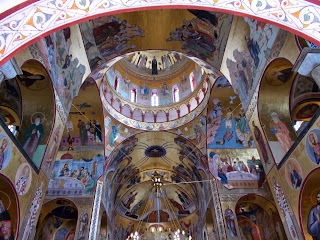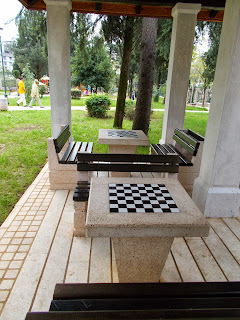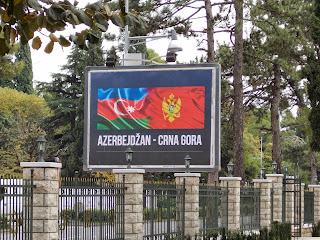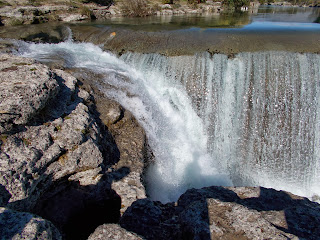 |
| Montenegro |
 |
| Skadar Lake |

We took the lightrail to the Frankfurt Airport where we
stood in the security line with 1000 people going to places I never dreamed I
would go : like Moscow and Vietnam: even Montenegro was communist when I was a kid, part of
Yugoslavia. We flew into Podgorica
(pronounced Pod-gore-eetsa) [known as ‘Titograd’ from 1946 to 1992] on
Montenegro Airlines: we got our first glimpse of the Adriatic Sea from the air
and saw Skadar Lake, which is on the border with Albania. We picked up our rental car, a brand-new VW
and checked into the Ramada Inn.

The
whole town was virtually leveled in WWII: the Allies bombed it when the Nazis
occupied the town and then the Germans bombed it after it was liberated. So there are lots of Soviet-era buildings and
crumbling concrete amidst the building boom now going on: Montenegro is
becoming a major tourist destination with great wilderness for hiking, fishing
and kayaking in spectacular canyons, camping and mountain biking balanced by
the high-end resorts and ports on the Adriatic.
“Casino Royale” was filmed here.
Within the same building as our hotel was the Mall of Montenegro, so we went ‘window shopping.’ There are 7 sections to the ‘Mall’ :
1. High end European and American stores, albeit with a
fairly limited inventory and high prices.
 |
| Burek |
2. Several very good
restaurants: one we enjoyed was ‘The Sicilian.’
We got pizza and Burek (small
savory pastries made with filo pastry and filled with ground meat, cheese or
spinach).
3. A full ‘western-style’
grocery store. We were able to buy BROWN
SUGAR! which is not available in Germany or most of the Balkans.
4. A huge fruit,
vegetable, spices and flower market filled the cavernous space in the center on
the ground floor.
5. On the second
floor balcony overlooking the produce market was a maze of small ‘shops’ like
you would see at an established flea market, each specializing in something
like running shoes, children’s clothing, plastic containers, brooms, or underwear. I bought some small spools of thread in
various colors, a coat zipper for a friend, and a kitchen tool like a piping
bag with a large star tip, except made of wood and steel, for making tulumbe, a deep-fried dessert like
Mexican churros.
 |
| tulumbe |
6. All around the
outside of the building were small shops selling stuff similar to 5, but more
variety. The shops are only about 10 x
12 feet in size and are open from 6 am to 10 pm. There I found a pair of waterproof shoes/low
boots for winter in Germany.
7. On the other side of the sidewalk from the small shops
were individuals seated on the ground with things to sell: fresh peppers,
blankets, hats, or hand knit thick wool socks.
I bought several pairs of socks (two pair from each of these women) as they cost less than the yarn alone in
the US. REALLY warm socks.
On Tuesday, we didn’t need to be at the hospital for the
closing ceremony until 2 so we went hiking on a local hill.
The elders have named it “Temple Hill.” I like that kind of optimism. Humanitarian missionaries have been in Montenegro for 2 years now: the Westwoods are the second couple. Proselyting elders have been there for about a year: there are only 2 elders in the whole country : they are part of the Adriatic North mission. Four Montenegrans have joined the church so far. We rent a clean,modern building in town, near the central business and shopping district where most people in town go walking every evening. We loved doing that: Podgorica is small enough that you can walk to the center from most anywhere in town.

Nice views of the mountains which surround the river valley and alluvial plain that Podgorica is built on. Lots of pines, cedars, figs; a few olive trees; some herb like dill which smelled delicious; and tiny pink cyclamen covering the hillsides.
On our way to the hospital, we stopped at the Cathedral of
the Resurrection [Saborni Hram Hristovog Vaskrsenja] the largest church in
Montenegro.
The Orthodox Metropolitanate of Montenegro and the Littoral has
existed continuously for 780 years as an integral diocese of the Serbian
Orthodox Church. It was founded in 1219 by St. Sava (Nemanjić), who also became
the first Archbishop of the Serbian Autocephalous Orthodox Church. The Church
was just finished and dedicated last week.
Brilliantly painted with Biblical scenes and with a huge mosaic of Noah
and the ark, it was beautiful.
 |
| Pelicans which are native ONLY to Skadar Lake |
The Westwoods had partnered with the central clinic and had
donated a special surgical microscope and chair for doing eye surgery. Crne Gore is 'Serbian' for Montenegro. I say 'Serbian' but Montenegrans and Bosnians and Croats all claim they have a different language from Serbian. Maybe a different dialect at best.
A blind man was begging out on the sidewalk in front of the hospital. I thought of Christ and Peter and wished I had the power to cure him
But Dr Engen from Salt Lake was able to help the doctors do just that : he had spent 2 days operating and teaching the doctors and staff how to use the equipment and new surgical techniques. He and his wife were on their first trip as Humanitarian specialists and were loving the experience in spite of being very tired.
The hospital sponsored a ceremony and reception to thank us (the LDS Church) for the donation: Elder Stay and I spoke, along with the director of the Children’s hospital. It was recorded and televised (we hope). President Rowe of the Adriatic North mission and the elders were also there.
The Engens and
Westwoods made up gift bags for the doctors and surgical nurses with Mo Tab cds
and chocolate. Engens were off to Serbia the
next day to teach in Beograd on a project the Maughans organized.
We walked into town for dinner with the Engens and Westwoods. We passed several monuments (including Sahat kula) and parks, crossed bridges and found figs, apples and pomegranets growing wild everywhere, saw a mosque and even a home with kiwi fruit growing all over a patio trellis.
 |
| sahat kula |
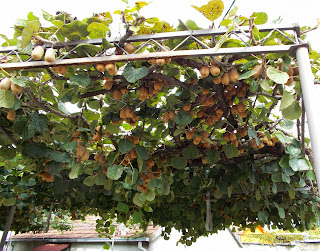 |
| Kiwi roof to a patio |
 |
| Pomegranates grow EVERYWHERE |
It turned out that Dr Engen had studied Material
Science Engineering at the U of Utah (that was my first major! I started in the
Merrill Engineering building way back in 1971).
On our way home we stopped at the chapel, met the missionaries and
President Rowe, talked for a while with a really well-educated investigator,
then bought a Palačinke (Balkan crepe spread with Nutella) on our way home.
 |
| Palačinke |
Wednesday we spent training the Westwoods, trying to explain
the vagaries of the computer programs we use for Humanitarian work (BAML=Bank
of America/Merrill-Lynch, CFIS = Church Financial Information System, CHaS =
Church Humanitarian System) to approve, pay for and report on projects. We found out that they had previously served a mission in Nauvoo - he had ended up as counselor to the mission president for 6 months - and were there at the SAME TIME that our good friend, Tristan Seaver, served as a performing missionary in Nauvoo! Kayleen even stayed with the Westwoods when she visited Tristan!
 |
| Elder and Sister Westwood and Elder Stay |
 |
| Where the elders live |
 |
| Just a bit of rain. . . |
 |
| Incredibly good orange torte |
 |
| Red Cross building : next project is to put in a wheelchair ramp where the Westwoods are standing. |
 |
| Millenium Bridge |
We had a lovely Italian lunch in the rain, visited the missionaries for a planning meeting, talked about Genesis (hey, it’s what I do!) and played some card games. We also delivered about 20 lbs of American food to the Westwoods: peanut butter, chocolate chips, vanilla, jello, and sweetened condensed milk. As the ONLY senior missionaries in the whole country, the Westwoods deserved a few days of R&R with people to talk to in English. We got treated to several recitations of Cowboy poetry, which we enjoy. Elder Westwood is active in both the Cowboy Poets of Utah and helps head up the group in Mesquite, where they live in the winter. Sister Westwood is active in teaching dance and a member of the tap/jazz dance group, the Mesquite Toes.
 |
| New hotel just built |
Thursday we woke to warmth and sunshine. We drove through Cetinje to Njegos’s mausoleum up on top of Mt. Lovcen, a shrine to the most favorite Montenegran poet, philospher and bishop.
 |
| Father and Mother of Montenegro |
In honor of the 200th anniversary of his birth, they held lots of cultural events and are rebuilding the path to his tomb.
From the cold, windswept top you could see mountains in all directions : Montenegro is well named! Tiny hamlets can be seen wherever there is some level ground (not much). Up high on the mountains are sheep and cattle pastures with shepherd huts now used by eco tourists.
 |
| Kotor Bay |
 |
| Tiny hamlet |
 |
| Adriatic Sea in the distance |



From Wikipedia:
Petar II Petrović-Njegoš (Serbian
Cyrillic: Петар
II Петровић Његош, pronounced [pêtar drûɡiː pětroʋit͡ɕ ɲêɡoʃ]; 13 November 1813 – 31 October 1851) was the Prince-Bishop
of Montenegro, the Serbian
Orthodox Metropolitan of Cetinje and a philosopher and poet, who, through his establishment of
Montenegrin secular organs, is considered to have been responsible for the
secularization of Montenegro. Njegoš was born in the village
of Njeguši,
near the town of Cetinje. Growing up
amongst illiterate peasants, he left his home at age eleven to be educated in
the Cetinje
monastery, at that time the only place of learning in Montenegro. Upon
the death of his uncle, Petar I, Njegoš became the Prince-Bishop
of Montenegro at the young age of seventeen. As a ruler and reformer, one of his
greatest achievements was persuading the feuding clan chiefs of Montenegro to
introduce fair taxation, as well as a codified set of laws based upon common
rights, into their primitive mountain communities. He became a leading
proponent of liberating and uniting the Serb people, willing even to concede
his princely rights in exchange for a union with Serbia. Although this did not
occur during his lifetime, he successfully laid foundations for political and
cultural ideas of Yugoslavism and at the same time introduced modern
political concepts to Montenegro. He held the position of Prince-Bishop
until his death of tuberculosis at the age of 37 in 1851.
Venerated
as a poet and philosopher, Njegoš is especially known for writing
the epic poem The Mountain Wreath, which is
considered to be a masterpiece of Serbian[6] and South Slavic literature, as well as the national epic of Montenegro, Serbia and both the Kingdom of Yugoslavia and the Socialist Federal Republic of
Yugoslavia. Following his death, he was buried in
a small chapel atop Mount Lovćen,
which was destroyed by the Austro-Hungarians during the First World War.
Afterwards, his remains were moved to the Cetinje Monastery and were then again
moved to the rebuilt chapel in 1925. The chapel was then, somewhat controversially,
replaced by Ivan Meštrović's mausoleum in 1974, with the support of
Yugoslavia's Communist government.
Njegoš has
remained largely influential in Montenegro, as well as in neighbouring
countries. His works have been used as ideological tools by a wide variety of
groups including irredentists, Serbian nationalists and Communists. In 2011, he was deemed
the "Montenegrin Shakespeare" by the British newspaper The Independent.
 |
| notice how steep the cliff sides are |
Next we went to Budva, now a resort town on the Adriatic coast for lunch down at the port.
The soups were the best part: borscht, broccoli soup, and fish soup
 |
| more Shopska salad |
 |
| This was what we got when Randy ordered 'steak' : it is a pork steak stuffed with ham and cheese |
 |
| Cat who came for lunch : he liked the pork steak |
We then drove down to Jaz beach to take a swim
The beach was all pebbles: I was surprised at
how hard it was to walk on without sinking down 6-8 inches! The ocean was warm and lovely.
Finally, we drove to Kotor Bay, probably the most famous part of Montenegro. Cruise ships now stop in what once was a well-fortified medieval port city. Because the Muslim Turks attacked (for about 500 years), the local monastery moved up on the mountainside and they built the city wall all the way up around it.
 |
| a catholic church |
 |
| reliquaries |
 |
| an othodox church |
 |
| Mary on the iconostasis |
 |
| Jesus icon on the iconostatis |
We
walked all around the old city, enjoying old churches and ice cream.
Each evening, because we had such late lunches, we opted to just buy a dessert. The Sicilian next door had a great variety of tortes, cheesecake and cakes. My favorites were a hazelnut, creme and orange reforma torta and a chocolate and orange filled layer cake.
Friday we drove out to Ostrog, a monastery built into the face of a cliff where St Basil lived, near the town of Niksic. We were thousands of feet up on a cliff-face on a narrow road: spectacular views, but a little anxiety in my stomach.
 |
| Ostrog Monastery |
St.
Basil's modesty made him reluctant to occupy high positions. However, his
piety, humility and dedication to the Church made him well suited for the role
and he was elected as Bishop of Zahumlje and Skanderija, which
he reluctantly accepted in 1639. He retired from the position ten years later
in 1649.
After his
death in 1671 he was buried at the Ostrog Monastery he had founded in Montenegro,
and his tomb in a cave-church soon became a site of pilgrimage for Christians (both Orthodox and Roman Catholic)
and Muslims drawn by reports of miracles occurring through the intercession of
the saint. The Monastery of
Ostrog is now one of
the major pilgrimage sites in the Balkans, and large numbers of pilgrims gather
particularly at Pentecost. St. Basil of
Ostrog is commemorated in the Serbian orthodox liturgical calendar on April 29.
Basil was a monk who helped many Christians escape the persecution of the Turks. His body is displayed there in his coffin in the tiny cave-church,
although other stories say the Turks so feared his veneration that they even
burned his bones.
Returning to Podgorica, we ate a late lunch at a restaurant called “Niagra” built on the banks of a river with a spectacular waterfall. They even created a waterfall INSIDE the restaurant and built a small shepherd’s hut next to it, complete with beautifully painted cradle and furniture. This time geese came walking thru past our table. Randy got roasted lamb which was incredibly delicious. I had fresh farmed trout from the stream.
 |
| Delicious lamb |
 |
| Geese who came to lunch |
We also walked around the old Turkish ruins by the Millenium Bridge over the Morača River which runs thru the center of town. The Ribnica Bridge [Most na Ribnici] (and nearby ruined Ottoman fortress) is near the confluence with the Morača and was built in the 15th century on the ruins of an older Roman bridge.
 |
| Uštipci |
 |
| roasted mediterranean vegetables, 'salty pancakes', and roasted potatoes for breakfast. |
 |
| More Shopska salad, tomatoes and other veggies and chees and meat trays |
Saturday morning we ate one last delicious breakfast
(shopska salad, fresh fruit and Uštipci – fried donut holes), packed our bags,
went for a walk on Gorica hill, saw St. George Church, [Crkva Svetog Đorđa]. Podgorica's oldest and prettiest church is
placed between fragrant trees at the foot of Gorica hill. Inside the simple
structure, the dark 16th century nave is adorned with 19th century icons and
frescoes. Then we headed for the airport.










































